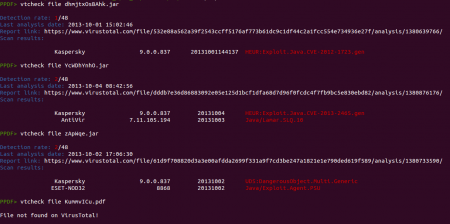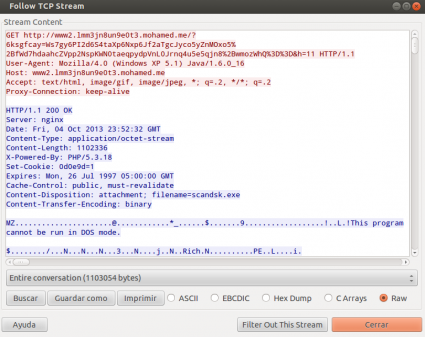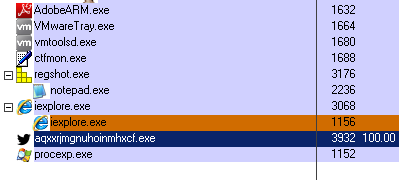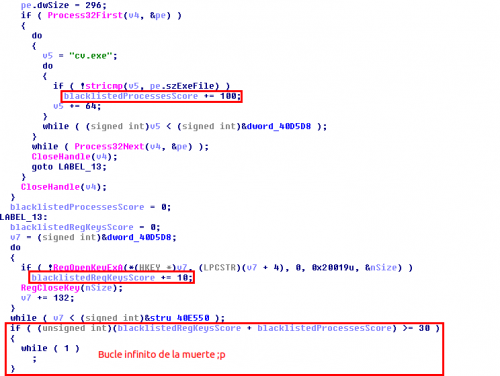Styx Exploit Kit instalando Simda |
Ya echaba de menos esos correos de SPAM con regalo que me llegaban hace un tiempillo y que, de repente, ya no llegaban. Me estaba empezando a preocupar... ;)
Dependiendo del servidor que responda al visitar la URL hxxp://gylaqim.com/exit.php nos puede redirigir a otra página como la inicial, con código Javascript malicioso y redirección a una página de viagra, o al exploit kit.
Las URLs inciales vistas hasta el momento son las siguientes:
hxxp://178.170.104.124/destruction.html
hxxp://178.170.104.124/seed.html
hxxp://actes-lyon.org/true.html
hxxp://aybabtu.ru/express.html
hxxp://brave.net.nz/ocean.html
hxxp://goozix.com/its.html
hxxp://moniwild.sakura.ne.jp/average.html
hxxp://rodinr.511.com1.ru/angle.html
hxxp://southeasterntrains-fail.com/somewhere.html
hxxp://toys-store.net/dawn.html
hxxp://toys-store.net/low.html
hxxp://webhydro.com/copy.html
Las URLs que redirigen al exploit kit tienen el siguiente formato:
hxxp://www3.ad63gyomll2jo237-1.usa.cc/?war0he=mbblKWampZqWdPsrJqgkqbe22%2BWaGVmp5qpaJyYlIg%3D
hxxp://www3.ad63gyomll2jo237-1.usa.cc/?xsp2a4=njZlp5pmpZqWdPsrJqgkqbe22%2BWaGVmqKynapVnlIg%3D
hxxp://www3.ev2okgoe5o6.usa.cc/?9fq8=XdvanKKraGfjdvYcpxqX9rlpKLcY5%2BgmqjHbaZoa4o%3D
hxxp://www3.ev2okgoe5o6.usa.cc/?c37spa463=h6ig12WbWhni%2BKlrJibldmp23PJZGeoo5qWbmqXqFY%3D
hxxp://www3.x-8hlldq1w50.usa.cc/?nxemgrrrxh=ku3O0aSnqSsjuSgdZWgktjlnbSbYZ6tmKbJqqmkqow%3D
hxxp://www3.y-83m4wjpzlx6.usa.cc/?2ef0=VtrPlLZicWWhWuPdraegnqqm0aOWql1tZqaWrGirJA%3D
Una vez que se visitan estas últimas URLs se obtiene un nivel más de redirección, hacia un i.html:
hxxp://www1.l5yhg95szx7k42.usa.cc/i.html
hxxp://www1.o-6vuo7jzwff5fv.usa.cc/i.html
hxxp://www1.qejt8wkvxre5a98.usa.cc/i.html
hxxp://www1.xjfvtg6bagx8.usa.cc/i.html
hxxp://www1.yi4f59df9s509dmg7.usa.cc/i.html
Tras desofuscar el código tendríamos lo siguiente:
A simple vista se pueden ver tres páginas diferentes dependiendo de la versión de Java instalada:
- La página “jorg.html” descarga el archivo “dhmjtxOsBAhk.jar” (cba750fafa12d9f53dedac9101d54180), un exploit de la vulnerabilidad “Java Applet Field Bytecode Verifier” (CVE-2012-1723).
- Tras visitar “jvvn.html” se descarga “YcWDhYnhO.jar” (f2a978cce12906af5bb9d91112143a1a) para intentar explotar el fallo del subcomponente 2D del JRE (CVE-2013-2463).
- Por último, la página “jply.html”, se descarga el archivo “CxolvGRXM.jnlp” para evitar el aviso de seguridad y el applet “zApWqe.jar” (5783988184709219c949fba03dead46e) con la intención de explotar la vulnerabilidad “Java Applet ProviderSkeleton” (CVE-2013-2460).
Si se visita “pdfx.html” nos encontramos, al igual que con “i.html”, un iframe (“mbahsldw.html”) más código Javascript para desofuscar el contenido del iframe. La segunda etapa del Javascript sería la siguiente:
hxxp://www2.lmm3jn8un9e0t3.mohamed.me/?6ksgfcay=Ws7gy6PI2dMOxo5%2BfWd7hdaahcZtaeqpydpVnL0Jrnq4u5e5qjn8%2BwmozWhQ%3D%3D&h=11
Al ejecutarse parece que algo no funcionaba correctamente, ya que el proceso creado estaba consumiendo el 100% de la CPU:
cv.exe
irise.exe
IrisSvc.exe
wireshark.exe
dumpcap.exe
ZxSniffer.exe
Aircrack-ngGui.exe
observer.exe
tcpdump.exe
WinDump.exe
wspass.exe
Regshot.exe
ollydbg.exe
PEBrowseDbg.exe
windbg.exe
DrvLoader.exe
SymRecv.exe
Syser.exe
apis32.exe
VBoxService.exe
VBoxTray.exe
SbieSvc.exe
SbieCtrl.exe
SandboxieRpcSs.exe
SandboxieDcomLaunch.exe
SUPERAntiSpyware.exe
ERUNT.exe
ERDNT.exe
EtherD.exe
Sniffer.exe
CamtasiaStudio.exe
CamRecorder.exe
Y las claves del registro:
Software\\CommView
SYSTEM\\CurrentControlSet\\Services\\IRIS5
Software\\eEye Digital Security
Software\\Microsoft\\Windows\\CurrentVersion\\Uninstall\\Wireshark
Software\\Microsoft\\Windows\\CurrentVersion\\App Paths\\wireshark.exe
Software\\ZxSniffer
Software\\Cygwin
Software\\Cygwin
Software\\B Labs\\Bopup ObserverAppEvents\\Schemes\\Apps\\Bopup Observer
Software\\B Labs\\Bopup Observer
Software\\Microsoft\\Windows\\CurrentVersion\\Uninstall\\Win Sniffer_is1
Software\\Win Sniffer
Software\\Classes\\PEBrowseDotNETProfiler.DotNETProfiler
Software\\Microsoft\\Windows\\CurrentVersion\\Explorer\\MenuOrder\\Start Menu2\\Programs\\Debugging Tools for Windows (x86)
SYSTEM\\CurrentControlSet\\Services\\SDbgMsg
Software\\Microsoft\\Windows\\CurrentVersion\\Explorer\\MenuOrder\\Start Menu2\\Programs\\APIS32
Software\\Syser Soft
Software\\Microsoft\\Windows\\CurrentVersion\\Uninstall\\APIS32
Software\\APIS32
Software\\Microsoft\\Windows\\CurrentVersion\\Uninstall\\Oracle VM VirtualBox Guest Additions
SYSTEM\\CurrentControlSet\\Services\\VBoxGuest
Software\\Microsoft\\Windows\\CurrentVersion\\Uninstall\\Sandboxie
SYSTEM\\CurrentControlSet\\Services\\SbieDrv
Software\\Classes\\Folder\\shell\\sandbox
Software\\Classes\\*\\shell\\sandbox
Software\\SUPERAntiSpyware.com
Software\\Classes\\SUPERAntiSpywareContextMenuExt.SASCon.1
Software\\SUPERAntiSpyware.com
Software\\Microsoft\\Windows\\CurrentVersion\\Uninstall\\ERUNT_is1
Este binario, entre otras cosas, manda cierta información del sistema como el lenguaje, versión del sistema operativo, ProductID, etc. a sus paneles de control.
wv=%s&uid=%d&lng=%s&mid=%s&res=%s&v=%08X
Dependiendo del tipo de petición se incluirá esta información o no, dentro de los siguientes parámetros:
controller=hash&mid=
controller=sign&data=%s&mid=%s
A su vez, estos parámetros se codifican y se envían como contenido de un parámetro de dos caracteres:
"?%c%c=%s"
Ambas son peticiones HTTP GET, usan un hostname con el formato "update%s.%s.com" y usan el siguiente User-Agent:
Mozilla/5.0 (Windows NT 6.1; WOW64; rv:2.0b8pre) Gecko/20101114 Firefox/4.0b8pre
Las IPs "hardcodeadas" a las que se enviaría esta información depende también del tipo de petición:
212.117.176.187 (hash)
79.133.196.94 (sign)
69.57.173.222 (sign)
Mozilla/4.0 (compatible; MSIE 8.0; Trident/4.0; .NET CLR 2.0.50727; .NET CLR 1.1.4322; .NET CLR 3.0.04506.590; .NET CLR 3.0.04506.648; .NET CLR 3.5.21022; .NET CLR 3.0.4506.2152; .NET CLR 3.5.30729)
Otros parámetros que se han visto en el código son los siguientes:
/?abbr=RTK&setupType=update&uid=%d&ttl=%s&controller=microinstaller&pid=3
http://malwaremustdie.blogspot.nl/2013/02/hulk-and-malware-crusaders-vs-fakeav.html
https://pastebin.com/zZ9nKEVP
http://www.virusradar.com/Win32_Simda.B/description
Lista de dominios / IPs / Whois info




